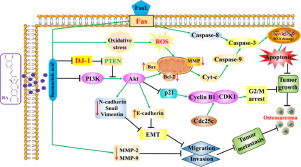当前位置:
X-MOL 学术
›
Phytomedicine
›
论文详情
Our official English website, www.x-mol.net, welcomes your feedback! (Note: you will need to create a separate account there.)
Rosmarinic acid exerts an anticancer effect on osteosarcoma cells by inhibiting DJ-1 via regulation of the PTEN-PI3K-Akt signaling pathway.
Phytomedicine ( IF 7.9 ) Pub Date : 2020-02-15 , DOI: 10.1016/j.phymed.2020.153186 Zhanjun Ma 1 , Jingjing Yang 2 , Yang Yang 2 , Xuexi Wang 3 , Guohu Chen 4 , Ancheng Shi 2 , Yubao Lu 2 , Shouning Jia 5 , Xuewen Kang 6 , Li Lu 7
Phytomedicine ( IF 7.9 ) Pub Date : 2020-02-15 , DOI: 10.1016/j.phymed.2020.153186 Zhanjun Ma 1 , Jingjing Yang 2 , Yang Yang 2 , Xuexi Wang 3 , Guohu Chen 4 , Ancheng Shi 2 , Yubao Lu 2 , Shouning Jia 5 , Xuewen Kang 6 , Li Lu 7
Affiliation

|
BACKGROUND
Osteosarcoma is the most common type of primary malignant bone tumor. This disease has exhibited a progressively lower survival rate over the past several decades, which has resulted in it becoming a main cause of death in humans. Rosmarinic acid (RA), a water-soluble polyphenolic phytochemical, exerts powerful anticancer effects against multiple types of cancer; however, its potential effects on osteosarcoma remain unknown. Hence, the present study investigated the efficacy of RA against osteosarcoma and aimed to clarify the mechanisms underlying this process.
METHODS
The effects of RA on cell viability, apoptosis, cell cycle distribution, migration, invasion, and signaling molecules were analyzed by CCK-8 assay, flowcytometric analysis, wound healing assay, Transwell assay, proteomic analysis, and use of shRNAs.
RESULTS
RA exerted anti-proliferation and pro-apoptotic effects on U2OS and MG63 osteosarcoma cells. Apoptosis was induced via extrinsic and intrinsic pathways by increasing the Bax/Bcl-2 ratio, triggering the intracellular production of reactive oxygen species (ROS), reducing the mitochondrial membrane potential (MMP), and upregulating the cleavage rates of caspase-8, caspase-9, and caspase-3. Additionally, RA suppressed the migration and invasion of osteosarcoma cells by inhibiting the expression levels of matrix metalloproteinase-2 and -9 (MMP-2 and -9), which are associated with a weakening of the epithelial-mesenchymal transition (EMT). Moreover, proteomic analyses identified DJ-1 as a potential target for RA. Several studies have indicated an oncogenic role for DJ-1 using knockdowns via the lentiviral-mediated transfection of shRNA, which caused the conspicuous suppression of cell proliferation, migration, and invasion as well as the arrest of cell cycle progression. At the molecular level, the expression levels of DJ-1, p-PI3K, and p-Akt were reduced, whereas the protein levels of phosphatase and tensin homologue (PTEN) were increased.
CONCLUSION
In conjunction with the high levels of DJ-1 expression in osteosarcoma tissues and cell lines, the present results suggested that RA exhibited anticancer effects in osteosarcoma cells by inhibiting DJ-1 via regulation of the PTEN-PI3K-Akt signaling pathway. Therefore, DJ-1 might be a biological target for RA in osteosarcoma cells.
中文翻译:

迷迭香酸通过调节PTEN-PI3K-Akt信号通路抑制DJ-1,从而对骨肉瘤细胞产生抗癌作用。
背景技术骨肉瘤是最常见的原发性恶性骨肿瘤类型。在过去的几十年中,该疾病的存活率逐渐降低,这已成为人类死亡的主要原因。迷迭香酸(RA)是一种水溶性多酚植物化学物质,对多种类型的癌症具有强大的抗癌作用。然而,其对骨肉瘤的潜在影响仍然未知。因此,本研究调查了RA抗骨肉瘤的功效,旨在阐明该过程的潜在机制。方法通过CCK-8测定,流式细胞术,伤口愈合测定,Transwell测定,蛋白质组学和shRNA的使用来分析RA对细胞活力,凋亡,细胞周期分布,迁移,侵袭和信号传导分子的影响。结果RA对U2OS和MG63骨肉瘤细胞具有抗增殖和促凋亡作用。通过增加Bax / Bcl-2比例,触发细胞内活性氧(ROS)的产生,降低线粒体膜电位(MMP)以及上调caspase-8,caspase的裂解率,通过外在和内在途径诱导细胞凋亡。 -9和caspase-3。此外,RA通过抑制基质金属蛋白酶2和-9(MMP-2和-9)的表达水平来抑制骨肉瘤细胞的迁移和侵袭,这与上皮-间质转化(EMT)的减弱有关。此外,蛋白质组学分析确定DJ-1为RA的潜在靶标。多项研究表明,通过慢病毒介导的shRNA转染,使用敲除技术可降低DJ-1的致癌作用,导致细胞增殖,迁移和侵袭的明显抑制,以及细胞周期进程的停止。在分子水平上,DJ-1,p-PI3K和p-Akt的表达水平降低,而磷酸酶和张力蛋白同源物(PTEN)的蛋白水平升高。结论结合骨肉瘤组织和细胞系中高水平的DJ-1表达,本研究结果表明RA通过调节PTEN-PI3K-Akt信号通路抑制DJ-1,从而在骨肉瘤细胞中表现出抗癌作用。因此,DJ-1可能是骨肉瘤细胞中RA的生物学靶标。和p-Akt减少,而磷酸酶和张力蛋白同源蛋白(PTEN)的蛋白质水平增加。结论结合骨肉瘤组织和细胞系中高水平的DJ-1表达,本研究结果表明RA通过调节PTEN-PI3K-Akt信号通路抑制DJ-1,从而在骨肉瘤细胞中表现出抗癌作用。因此,DJ-1可能是骨肉瘤细胞中RA的生物学靶标。和p-Akt减少,而磷酸酶和张力蛋白同源蛋白(PTEN)的蛋白质水平增加。结论结合骨肉瘤组织和细胞系中高水平的DJ-1表达,本研究结果表明RA通过调节PTEN-PI3K-Akt信号通路抑制DJ-1,从而在骨肉瘤细胞中表现出抗癌作用。因此,DJ-1可能是骨肉瘤细胞中RA的生物学靶标。
更新日期:2020-02-20
中文翻译:

迷迭香酸通过调节PTEN-PI3K-Akt信号通路抑制DJ-1,从而对骨肉瘤细胞产生抗癌作用。
背景技术骨肉瘤是最常见的原发性恶性骨肿瘤类型。在过去的几十年中,该疾病的存活率逐渐降低,这已成为人类死亡的主要原因。迷迭香酸(RA)是一种水溶性多酚植物化学物质,对多种类型的癌症具有强大的抗癌作用。然而,其对骨肉瘤的潜在影响仍然未知。因此,本研究调查了RA抗骨肉瘤的功效,旨在阐明该过程的潜在机制。方法通过CCK-8测定,流式细胞术,伤口愈合测定,Transwell测定,蛋白质组学和shRNA的使用来分析RA对细胞活力,凋亡,细胞周期分布,迁移,侵袭和信号传导分子的影响。结果RA对U2OS和MG63骨肉瘤细胞具有抗增殖和促凋亡作用。通过增加Bax / Bcl-2比例,触发细胞内活性氧(ROS)的产生,降低线粒体膜电位(MMP)以及上调caspase-8,caspase的裂解率,通过外在和内在途径诱导细胞凋亡。 -9和caspase-3。此外,RA通过抑制基质金属蛋白酶2和-9(MMP-2和-9)的表达水平来抑制骨肉瘤细胞的迁移和侵袭,这与上皮-间质转化(EMT)的减弱有关。此外,蛋白质组学分析确定DJ-1为RA的潜在靶标。多项研究表明,通过慢病毒介导的shRNA转染,使用敲除技术可降低DJ-1的致癌作用,导致细胞增殖,迁移和侵袭的明显抑制,以及细胞周期进程的停止。在分子水平上,DJ-1,p-PI3K和p-Akt的表达水平降低,而磷酸酶和张力蛋白同源物(PTEN)的蛋白水平升高。结论结合骨肉瘤组织和细胞系中高水平的DJ-1表达,本研究结果表明RA通过调节PTEN-PI3K-Akt信号通路抑制DJ-1,从而在骨肉瘤细胞中表现出抗癌作用。因此,DJ-1可能是骨肉瘤细胞中RA的生物学靶标。和p-Akt减少,而磷酸酶和张力蛋白同源蛋白(PTEN)的蛋白质水平增加。结论结合骨肉瘤组织和细胞系中高水平的DJ-1表达,本研究结果表明RA通过调节PTEN-PI3K-Akt信号通路抑制DJ-1,从而在骨肉瘤细胞中表现出抗癌作用。因此,DJ-1可能是骨肉瘤细胞中RA的生物学靶标。和p-Akt减少,而磷酸酶和张力蛋白同源蛋白(PTEN)的蛋白质水平增加。结论结合骨肉瘤组织和细胞系中高水平的DJ-1表达,本研究结果表明RA通过调节PTEN-PI3K-Akt信号通路抑制DJ-1,从而在骨肉瘤细胞中表现出抗癌作用。因此,DJ-1可能是骨肉瘤细胞中RA的生物学靶标。

























 京公网安备 11010802027423号
京公网安备 11010802027423号